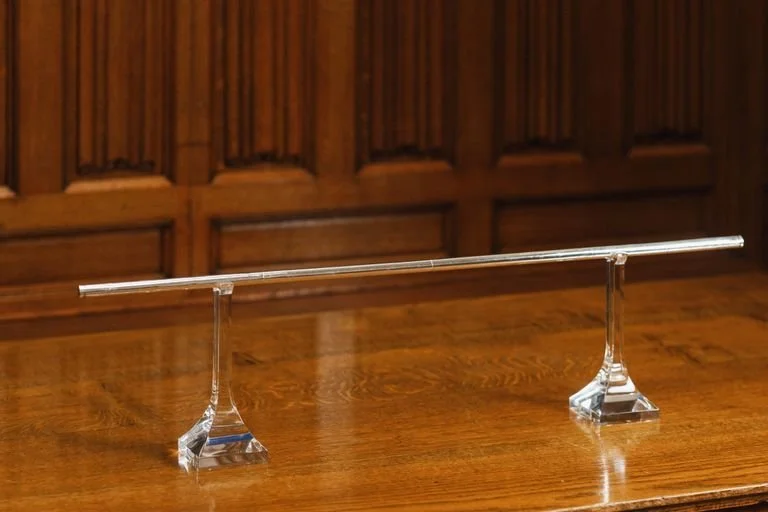
The Wilford Archive
A Taylors Yardstick
Transcript:
Recovery of the Company’s ancient YARD STICK
The Clerk reported that he had received from the office of the previous Clerk of the Company a metal yardstick previously the property of the Company and which had been found behind a cupboard in his office, where it was discovered when the cupboard was being removed and the Court was very appreciative of the return of this item of the Company’s possessions.
The Clerk at the time was Herbert Harrowell – senior partner of Harrowells Solicitors. The previous Clerk referred to in the Minute, was H Walter Badger. Unfortunately the Yardstick has not been seen since and no subsequent minutes have been found making reference to it.
So – what do know about the Yardstick?
· It is referred to in the Minute as of a ‘metal’ yardstick, so presumably was made of brass. Why it is referred to as ‘ancient ‘ is unknown. Was it perhaps because it was engraved with merchant taylors’ arms, a date or other detail and graduated into ‘nails’ – 1/16th of a yard – one of the standard units of length of the time?
· It would have been the standard measure of ‘one yard’ for the tailoring industry in York, held by the Company of Merchant Taylors in its regulatory role.
The above is of current interest because when Members of the Company visited the Hall of the London Company of Merchant Taylors in May 2025, they were shown that Company’s splendid silver yardstick, which was on display for the visit, and which they refer to as ‘The Cloth Yard’. Details of the London Company’s Cloth Yard follow and made the York Company Members reflect on what the York Company was missing.
The London Company of Merchant Taylors’s Cloth Yard
Details taken from their website
The Cloth Yard – made circa 1500-1509
The Cloth Yard is one of the earliest pieces of silver belonging to the Company, and is thought to be the only measure of its kind surviving from the late medieval world. It is made of silver, which is delicately engraved with the Company coat of arms. It has an iron core - making it surprisingly heavy! It originally also bore the engraved symbol of King Henry VII (an H topped by a crown), but this was unfortunately polished out.
The Cloth Yard is recorded in the Company accounts from 1512, and was likely made sometime between 1500 and 1509 (when Henry VII died). In 1598, the Company Beadle pretended the Yard had been stolen and tried to run off with the money given to him by the Company to replace it. Mercifully, this treasure returned safely to the Hall, and the Beadle was thrown into debtors' prison for fraud.
The Cloth Yard is divided into four, nine inch sections, one of which is further divided into two lengths of 2¼ inches, and one of 4½ inches. These divisions, known as ‘nails’, were the common measures used by late medieval cloth merchants. The Company would use the Yard each summer at England’s most important annual cloth market, Bartholomew Fair in Smithfield.
From the fifteenth century, the Merchant Taylors and Drapers had powers to regulate the cloth trade at the Fair. The Company Wardens, Clerk and Beadle toured the fair each year, using the Yard to check the measures at the various cloth stalls. This must have been a difficult task, verging on dangerous, surrounded by the equivalent of a very rowdy football crowd! They were therefore accompanied by the Lord Mayor’s “Sergeant at Mace” - a dignified title for an official bouncer.
Bartholomew Fair in Smithfield was the most important annual market for the wool and cloth trades in England. The modern street, Cloth Fair, is named after it. The Fair was held in and around St Bartholomew’s Hospital on St Bartholomew’s Day (the 24th of August). It was always a rowdy event, as anyone travelling to, attending, or returning from the fair, had immunity from arrest. There were theatrical shows, prize fights, gambling, and even wild rabbit chasing, all accompanied by vast quantities of drink, and no police! The City finally managed to have it closed down in 1855. So far as we know, the Cloth Yard has not been used since.
---000---
The following interesting aside about the Cloth Yard – referred to in this instance as their ‘yardstick’ - was provided by the London Company’s Curator following the Visit:
I recently found a note in the account books relating to the symbolic display of the yardstick as a symbol of authority at meetings of the Bachelors' Company. The Bachelors were a sort of Company within the Company comprised of younger working tailors. There were centuries of strife between the body of Bachelors and the Company proper, and this decision in the 1680s where the Company permitted the Bachelors this privilege of displaying the yardstick was a real coup.
GAW
July 2025

